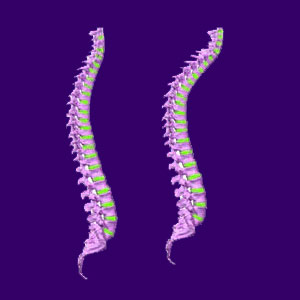
Kyphosis is defined as the degree of front to back curvature in the upper back, as well as the lowest parts of sacral-coccygeal vertebral column. It is a term sometimes also used to describe an abnormality in the degree of curvature demonstrated in either of these areas. In virtually all cases, kyphotic change is a condition which affects the thoracic spinal region. This upper back area normally demonstrates a kyphotic curvature in a typical anatomy, meaning that the open end of the curve faces front.
In a hyperkyphotic condition, this curvature is exaggerated and can create a noticeable physical deformity of the middle back. Meanwhile, in a hypokyphotic vertebral column, the curvature is lacking to one degree or another. This unusual spinal curvature often coexists with other curvature related conditions, such as scoliosis or lordosis.
This resource section provides a comprehensive view of front-to-back kyphotic spinal curvature in the thoracic and sacrococcygeal spinal zones.
Spinal Hyperkyphosis
Most diagnosed patients will demonstrate mild to moderate forms of this exaggerated curvature condition. Some patients are not even aware of their abnormal curvature, since it produces no pain and little outward physical change. Many patients simply feel they have bad posture when actually they have an exaggerated thoracic kyphotic curvature. Other patients are aware of the condition due to the unusual visual profile it often creates in their spinal anatomy.
Patients with moderate to severe forms of kyphotic curvature will often show a protrusion of the middle back, forming a large mound or lump. This condition has been referred to by many less than flattering names in past medical literature including hunchback, roundback or humpback. These terms are deemed derogatory and cruel, so they should never be used.
Read more about the diagnosis of Scheuermann’s Disease.
Hypokyphosis
Hypokyphotic spinal profiles are not as common, but can exist due to structural issues in the vertebral column, or more commonly, muscular interactions which may reduce the curve to a noticeable degree. Severe muscle spasm due to injury or ischemia can pull the spine tightly and create a loss of kyphotic curvature, most always in the thoracic region. This loss of curvature may be pronounced when viewed through a diagnostic imaging study, but is unlikely to be visible upon normal observation of the patient’s body.
In muscular-induced instances, this can be a transient health condition, while when it is structurally-motivated, may be permanent. Common names for this condition include flat back, flat spine, straight back or straight spine.
Kyphosis Condition
Mild to moderate conditions are usually symptom free, although they are often blamed for causing otherwise idiopathic back pain. Kyphotic curves, like many innocent spinal abnormalities, are often the target of blame for unrelated back symptoms. Most chronic cases of severe back ache are coincidental to any mild abnormal kyphotic curvature. In these cases where pain is present, the true cause is likely to be either a completely different anatomical issue or a combination of psychological back pain and/or diagnostic nocebo effect.
Severely exaggerated or reduced kyphotic curves are rare, can but be a big problem for the patient. These conditions can be painful and produce many other troublesome health concerns. Some advanced kyphotic curves can actually become lethal if allowed to progress. They can cause internal organ damage and prevent normal physical functionality. In these cases, treatment is appropriate and advised.
Learn more about the causes of kyphotic back pain.
Causes of Kyphosis
A hyperkyphotic or hypokyphotic spinal expression can come from a variety of different possible causes:
Congenital kyphotic conditions can make a person prone to developing hyper or hypokyphotic curves as they grow.
Nutritional kyphosis can occur due to vitamin and mineral deficiency.
Osteoarthritis can contribute to the condition by changing the normal spinal anatomy. This is one of the normal reasons for thoracic kyphotic alternation in the elderly.
Osteoporosis is also a prime contributor to kyphotic development in senior citizen patients.
Spinal injury can change the spinal curvature immediately or over time due to trauma.
Spinal fusion surgery can create tremendous pressure in the spine influencing vertebral levels surrounding the fusion site. This can create an increased or decreased kyphotic curve in the spine.
Postural kyphotic change is most prevalent in the elderly and in developing teens.
Consequences of Kyphotic Changes
Most mild to moderate atypical kyphotic curves are harmless, even if they are visually abnormal. Pain and other symptoms are uncommon with these minor forms of kyphotic curvature. If you have severe pain blamed on a mild curve, there is a good chance that your pain has been misdiagnosed. Make sure to consider this possibility before undergoing any drastic treatment for your unusual kyphosis.
Patients with severe kyphotic curves might require ongoing conservative or drastic invasive treatment. The most common modalities are physical therapy, pain management drugs, bracing and back surgery. Make sure to discuss all the back pain treatment options with your doctor before deciding on a definitive plan of action.
Read more about kyphotic curvature treatment.





